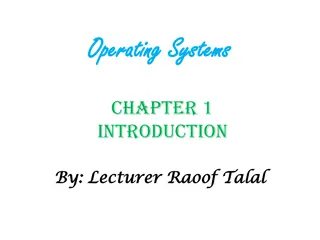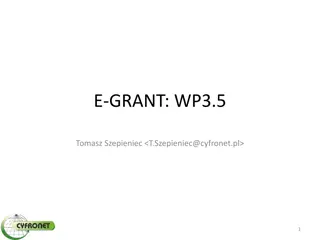Operating System: File Allocation Methods
File allocation methods in operating systems determine how files are stored in disk blocks. The main methods include Contiguous Allocation, Linked Allocation, and Indexed Allocation. Contiguous Allocation involves allocating blocks in a contiguous manner for efficient disk space utilization and fast access. Linked List Allocation overcomes drawbacks of Contiguous Allocation by treating each file as a linked list of disk blocks. Each method has its advantages and disadvantages, impacting file access efficiency and disk space management.
- File Allocation Methods
- Operating Systems
- Contiguous Allocation
- Linked Allocation
- Disk Space Utilization
Download Presentation

Please find below an Image/Link to download the presentation.
The content on the website is provided AS IS for your information and personal use only. It may not be sold, licensed, or shared on other websites without obtaining consent from the author. Download presentation by click this link. If you encounter any issues during the download, it is possible that the publisher has removed the file from their server.
E N D
Presentation Transcript
OPERATING SYSTEM FILE ALLOCATION METHODS
FILE ALLOCATION The allocation methods define how the files are stored in the disk blocks. There are three main disk space or file allocation methods. Contiguous Allocation Linked Allocation Indexed Allocation The main idea behind these methods is to provide: Efficient disk space utilization. Fast access to the file blocks.
CONTIGUOUS ALLOCATION Contiguous allocation is one of the most used methods for allocation. Contiguous allocation means we allocate the block in such a manner, so that in the hard disk, all the blocks get the contiguous physical block. We can see in the below figure that in the directory, we have three files. In the table, we have mentioned the starting block and the length of all the files. We can see in the table that for each file, we allocate a contiguous block.
Advantages of Contiguous Allocation The contiguous allocation method gives excellent read performance. Contiguous allocation is easy to implement. The contiguous allocation method supports both types of file access methods that are sequential access and direct access. The Contiguous allocation method is fast because, in this method number of seeks is less due to the contiguous allocation of file blocks.
Disadvantages of Contiguous allocation The disadvantages of contiguous allocation method are: In the contiguous allocation method, sometimes disk can be fragmented. In this method, it is difficult to increase the size of the file due to the availability of the contiguous memory block.
Linked List Allocation The linked list allocation method overcomes the drawbacks of the contiguous allocation method. In this file allocation method, each file is treated as a linked list of disks blocks. In the linked list allocation method, it is not required that disk blocks assigned to a specific file are in the contiguous order on the disk. The directory entry comprises of a pointer for starting file block and also for the ending file block. Each disk block that is allocated or assigned to a file consists of a pointer, and that pointer point the next block of the disk, which is allocated to the same file.
Advantages of Linked list allocation There are various advantages of linked list allocation: In liked list allocation, there is no external fragmentation. Due to this, we can utilize the memory better. In linked list allocation, a directory entry only comprises of the starting block address. The linked allocation method is flexible because we can quickly increase the size of the file because, in this to allocate a file, we do not require a chunk of memory in a contiguous form.
Disadvantages of Linked list Allocation Linked list allocation does not support direct access or random access. In linked list allocation, we need to traverse each block. If the pointer in the linked list break in linked list allocation, then the file gets corrupted. In the disk block for the pointer, it needs some extra space.
Indexed Allocation The Indexed allocation method is another method that is used for file allocation. In the index allocation method, we have an additional block, and that block is known as the index block. For each file, there is an individual index block. In the index block, the ith entry holds the disk address of the ith file block. We can see in the below figure that the directory entry comprises of the address of the index block.
Advantages of Index Allocation The index allocation method solves the problem of external fragmentation. Index allocation provides direct access.
Disadvantages of Index Allocation In index allocation, pointer overhead is more. We can lose the entire file if an index block is not correct. It is totally a wastage to create an index for a small file.























